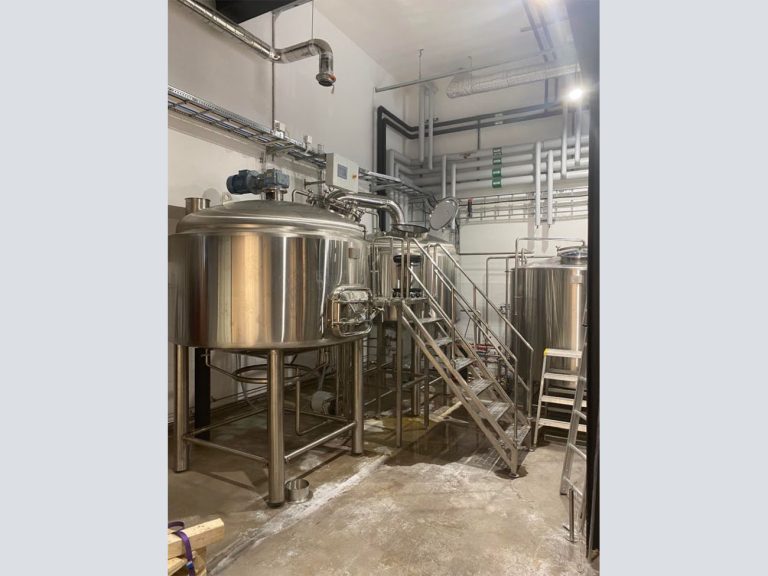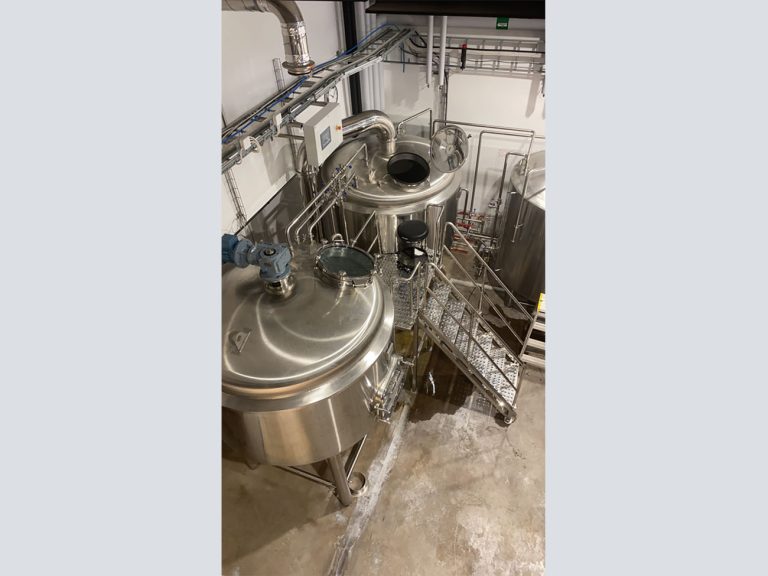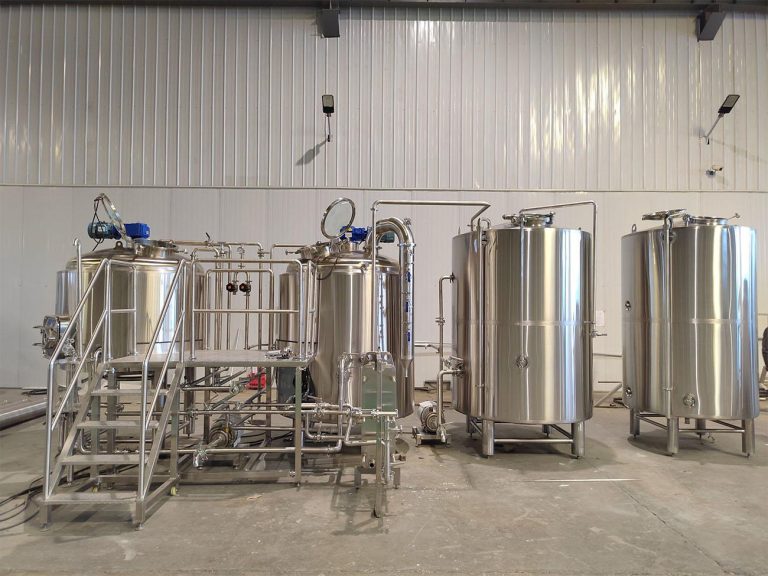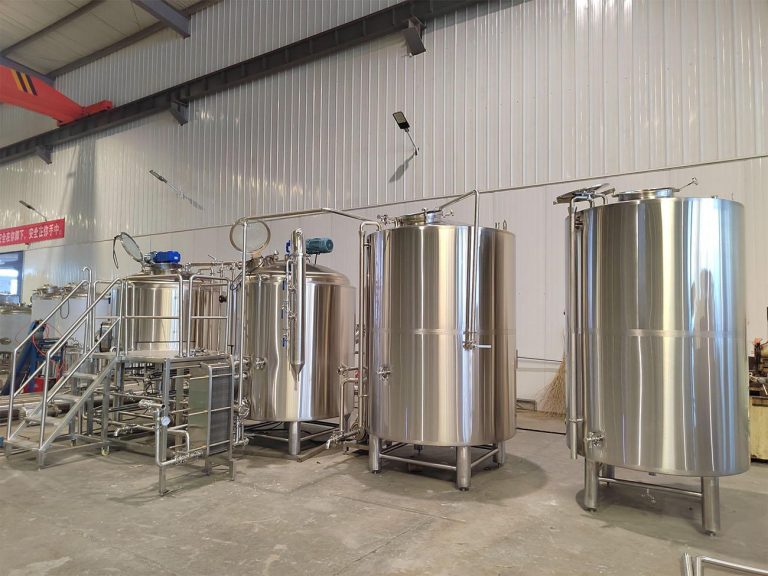



A 1000L microbrewery system refers to a brewing setup with a capacity of 1000 liters for producing beer. This scale of brewing allows for producing a significant amount of beer per batch, catering to small-to-medium-sized breweries or craft beer operations. It provides a good balance between volume and flexibility for experimenting with different beer styles and recipes while still being manageable in terms of production and space requirements.
A 1000L microbrewery system refers to a brewing setup with a capacity of 1000 liters for producing beer. This scale of brewing allows for producing a significant amount of beer per batch, catering to small-to-medium-sized breweries or craft beer operations. It provides a good balance between volume and flexibility for experimenting with different beer styles and recipes while still being manageable in terms of production and space requirements.
2.1000L micro brewing system specification:
| Output/Brew | 1000L |
| Brew/Week | 2~6 |
| Output/Week | 2000L~6000L |
| Electric Supply | 3phase/380(208, 415,480,575…)v/50 (60)Hz |
| Heating Source | Electric/Steam/Direct Fired Heating |
| Area Request | >70m2 |
| Brewmaster | 1 |
3.1000L Micro Brewing System Configuration:
| Name | Components | Specification |
| Grain Milling Unit | Grain miller | Stainless steel 304, Double roller, rollers distance adjustable |
| Grain auger | Conveys grist from malt mill to grist case;
Inside stainless screw, outside PPR protection tube; Associated motor with frequency conversion. |
|
| SS grist hopper | Stainless steel304 | |
| Brewhouse system | Mash/lauter tun | Grain rake with VFD Laser cutting V-wire False Bottom Easy clean and detachable sparging spray ring Multihole wort collect ring, anti-rinserWith side grain out doorTank light assembliesMash hydration assemblyRotary CIP spray ballsLevel sight tube. |
| Boiling kettle/whirlpool tank | Steam Jacket /direct gas fired heating/electric heating Steam vent with condensate ring for kettle stackTank light assembliesRotary CIP spray ballsTangential whirlpool entryLevel sight tube. |
|
| Wort pump | Sanitary wort pumps with variable speed control. | |
| Working platform | OSHA compliant platforms with safety railings & stairs, Cellar package with brewers hoses, valves and fittings . | |
| Hot liquor tank | Steam Jacket heating/direct gas fired heating/electric heating
Sight gauge for water level With SS HLT pump with variable speed control. |
|
| Wort chiller | SUS304/316 plate, with wort aeration system. | |
| Beer Fermenters/unitanks | Beer fermenter | Interior and exterior finish polished to a sanitary finish
Interior finish pickled and passivated Exterior brushed, #4 finish Fully welded exterior shell 60 degree cone bottom, with an average of 25% head space Rotating racking port Glycol cooling jacket on cone and bottom Ladder hooks Inoxpa butterfly valves, sample valve, 2” pressure vacuum relief valve RTD Probe Tension braces on legs Sanitary tri-clamp connections. |
| Serving&bright beer tanks | Bright beer tank | Inoxpa butterfly valves, Perlick sample valve
Micromatic level gauge, PVRV Clamps and gaskets, pressure gauge, carb stone Stainless steel legs with stainless leveling footpads Interior shell: 304 stainless steel, thickness 3mm Exterior shell: 304 stainless steel, thickness 2mm Interior and exterior finish polished to a sanitary finish Interior finish pickled and passivated Exterior brushed, #4 finish Fully welded exterior shell Dished top and bottom, with an average of 15%-20% head space Carbonation port Side or top manway door, Dimple jacket cooling jackets Polyurethane insulation Level gauge connections CIP arm and spray ball Sanitary tri-clamp connections. |
| Glycol cooling system | Glycol tank | Insulated conical top and sloped bottom
Liquid level sight tube for water level Rotating CIP spray ball. |
| Cold water tank | Cooling jacket on tank with PU insulation
Liquid level sight tube for water level Rotating CIP spray ball. |
|
| Glycol chiller | Assembly unit, wind cooling, environmental refrigerant: R404a or R410a, compressors and electrical components meet UL/cUL/CE certified | |
| Glycol/cold water pump | Sanitary SUS304, VFD control | |
| Control unit | Brewhouse and fermentation process Controlling | Manual button control panel or PLC control with touch screen for special, control panel with RTD & solenoid valves. |
| CIP unit system | Caustic tank | Electric heating element inside |
| Sterilize tank | Stainless steel 304 | |
| Transfer&Control | Portable sanitary CIP/wort pump, SS cart & VFD controller | |
| Others | Option | Piping flow panel for Brewhouse |
| Brewhouse Separate PLC Controller |
4.Advantages of a 1000L micro brewing equipment:
A 1000L microbrewing equipment offers several advantages for craft breweries aiming to produce beer on a moderate commercial scale:
Volume Efficiency: Produces a substantial volume of beer per batch, allowing for larger-scale production compared to smaller systems, catering to moderate demand.
Flexibility: Offers a good balance between volume and flexibility, enabling breweries to experiment with various recipes and styles while still maintaining a manageable production scale.
Consistency: Allows for better consistency in production compared to smaller setups, as larger volumes often lead to more stable brewing conditions and processes.
Economies of Scale: While still considered a microbrewery, a 1000L system can benefit from some economies of scale in terms of ingredient purchases and production efficiency compared to smaller setups.
Expansion Potential: Provides room for growth and scalability within the microbrewery market without requiring a significant leap in infrastructure or equipment.
Market Demand: Satisfies the demand for craft beer in local markets and allows breweries to potentially expand their distribution to a wider audience.
Operational Efficiency: Streamlines brewing operations by handling larger batches, reducing labor per unit of beer produced compared to smaller systems.
Space Utilization: While larger than smaller systems, a 1000L brewery can still fit well within a reasonably sized brewing facility or brewpub, optimizing space utilization.
Investment Return: Offers a balance between initial investment and potential returns, making it an attractive choice for entrepreneurs entering the craft beer market.
5.What factors should be considerations about 1000L micro brewing equipment:
Several crucial factors should be considered when contemplating a 1000L microbrewery system:
Space Requirements: Ensure your brewing space can accommodate the equipment, including access for installation, operation, and maintenance.
Budget: Assess the initial investment cost for the equipment, installation, and any additional infrastructure or modifications required.
Utility Needs: Evaluate water, electricity, and gas requirements for the system, ensuring your brewery has the necessary utilities in place.
Regulations and Compliance: Understand and comply with local, state, and federal regulations related to brewing, including licensing, health, safety, and environmental standards.
Operational Expertise: Ensure your team has the knowledge and expertise to operate and maintain the equipment effectively to produce quality beer consistently.
Scaling Capabilities: Assess the scalability of the system in case you plan to expand production in the future. Consider whether the equipment can handle increased demand without significant modifications.
Support and Service: Research the manufacturer’s reputation for customer support, availability of spare parts, and maintenance services to avoid downtime during equipment issues.
Brewery Layout and Workflow: Design the brewery layout to optimize workflow and efficiency, considering the placement of equipment for smooth production processes.
Environmental Impact: Evaluate the sustainability of the brewing process and equipment, considering energy consumption, water usage, and waste management practices.
Market Demand and Competition: Analyze the local market for craft beer, understanding the demand and competition to position your brewery effectively.
Conclusion:
A 1000L microbrewery system refers to a brewing setup capable of producing 1000 liters of beer per batch. This kind of system is typically used by craft breweries or smaller-scale operations. These systems allow for more control over the brewing process and can cater to small to medium-scale production. They’re popular among craft brewers due to their flexibility in experimenting with different recipes and producing a variety of beer styles.